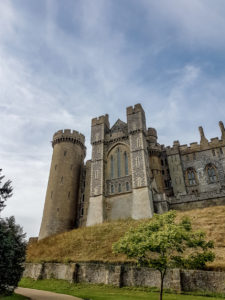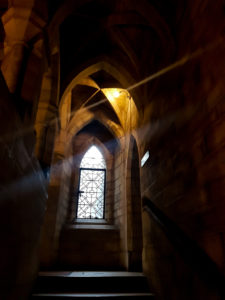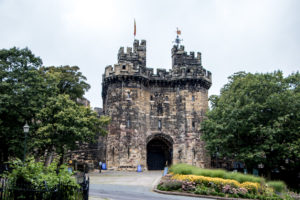Arundel Castle is a restored and remodeled medieval castle in Arundel, West Sussex, England. It was established by Roger de Montgomery on Christmas Day 1067. Roger became the first to hold the earldom of Arundel by the graces of William the Conqueror. The castle was damaged in the English Civil War and then restored in the 18th and 19th centuries by Charles Howard the 11th Duke of Norfolk.
From the 11th century, the castle has been the seat of the Earl of Arundel and, for over 400 years, the Duke of Norfolk.
The original structure was a motte and double bailey castle. Roger de Montgomery was declared the first Earl of Arundel as the King granted him the property as part of a much larger package of hundreds of manors.
Roger, who was a cousin of William, had stayed in Normandy to keep the peace there while William was away in England. He was rewarded for his loyalty with extensive lands in the Welsh Marches and across the country, together with one-fifth of Sussex (Arundel Rape). (For other reasons, the generally accepted first creation of the title Earl of Arundel lies in the year 1138 with William d’Aubigny, confirmed in 1155.)
After Roger de Montgomery died, the castle reverted to the crown under Henry I. The King, in his will, left Arundel Castle and the attached land to his second wife Adeliza of Louvain.[citation needed] In 1138, three years after Henry’s death, she married William d’Albini II (aka d’Aubigny, the first Earl, of the d’Aubigny family of Saint-Martin-d’Aubigny in Normandy).
From 1138 to the present day Arundel Castle and the Earldom of Arundel have passed by inheritance, in all but two or three generations in a direct male line, and with only two or three temporary forfeitures to the crown. Since the Aubigny family first acquired the castle progressive changes have been made and the castle has been re-structured to meet the requirements of modern times.
In 1139 Empress Matilda was invited to stay at Arundel during her travels to press her claim to the English throne upon King Stephen. The apartments constructed to accommodate her and her entourage survive to this day.
In 1176 William d’Aubigny, 1st Earl of Arundel died and Arundel Castle reverted to the crown, under King Henry II, who spent a vast amount of money re-structuring the building, mainly for domestic needs. When Henry died the castle remained a possession of his son and heir King Richard I (“the Lionheart”), who offered it to William d’Aubigny, 3rd Earl of Arundel. The last in the Aubigny male line was Hugh d’Aubigny, 5th Earl of Arundel, who died at an early age in 1243. When his sister and heiress Isabel d’Aubigny married John FitzAlan of Clun, he became the 6th Earl of Arundel and inherited the castle. The FitzAlan family continued in an unbroken male line until 1580 but were twice temporarily deprived of their estates.
Upon the death of John FitzAlan, 7th Earl of Arundel in 1272, Arundel Castle and the earldom passed to his five-year-old son Richard FitzAlan, 8th Earl of Arundel. Thirteen years later, King Edward I granted the 8th Earl the right to hold two fairs per annum at Arundel with the right to impose taxation. This grant provided funding for a much-needed renovation of the castle, which had fallen into disrepair.
Once sufficient funds were available, the 8th Earl added the well tower and re-constructed the entrance to the keep. His son Edmund FitzAlan, 9th Earl of Arundel was executed for his part in the rebellion against King Edward II. Arundel Castle was forfeited to the crown and was granted by the king to his half-brother Edmund of Woodstock, 1st Earl of Kent (1301-1330), the 6th son of Edward I by his second wife Margaret of France. Edmund of Woodstock was executed by Queen Isabella and her lover Mortimer for his support of her husband Edward II, and his widow and orphaned children (including Joan of Kent (1326/7-1385) (the “Fair Maid of Kent”), future mother of King Richard II) were placed under house arrest at Arundel Castle. The castle and titles were restored to the FitzAlans four years later.
Richard FitzAlan, 10th Earl of Arundel, fought at the Battle of Crécy with Edward III and his son the Black Prince. The 10th Earl ordered the building of the FitzAlan Chapel, completed posthumously according to his will. One of his daughters, Alice FitzAlan, married Thomas Holland, 2nd Earl of Kent (1350-1397) whose mother Joan, “Fair Maid of Kent”, had spent her infancy under house arrest at Arundel Castle.
Richard FitzAlan, 11th Earl of Arundel was treated harshly by Richard II. At the funeral of his wife Queen Anne of Bohemia, the Earl was beaten for arriving late and asking to leave early. Richard II eventually grew tired of his treachery and executed him before confiscating his property which he gave to one of his elder half-brothers John Holland, 1st Duke of Exeter (1352-1400) (a son of Joan, “Fair Maid of Kent”), but when the Duke was executed by King Henry IV (who had deposed Richard II), Arundel was returned to the FitzAlan line once again. Thomas FitzAlan, 12th Earl of Arundel married a daughter of King John of Portugal and the couple eventually became the first members of the FitzAlan family to be buried in the FitzAlan Chapel built by the 10th Earl.
The FitzAlan male line ceased on the death of Henry FitzAlan, 19th Earl of Arundel, whose daughter and heiress Mary FitzAlan married Thomas Howard, 4th Duke of Norfolk, to whose descendants the castle and earldom passed. The crown seized Arundel upon his execution for conspiring to marry Mary, Queen of Scots in 1572. The castle was later returned to his Howard heirs, the successor Earls of Arundel.












